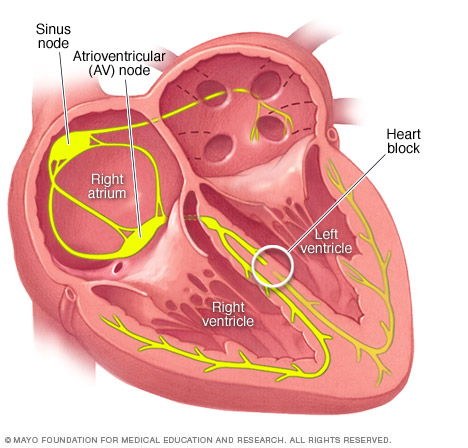Overview
Bundle branch block

Bundle branch block
Electrical impulses that cause your heart to beat (contract) start in the heart's upper right chamber (right atrium) and travel to the lower chambers (ventricles). In bundle branch block, the pathway these impulses follow is delayed or blocked. The pathway includes two branches — the left and the right bundles. If one bundle is damaged, the ventricles rely on the other bundle to receive and respond to signals from the right atrium. If both bundles are blocked, the heart may beat very slowly, which can require a pacemaker.
Bundle branch block is a condition in which there's a delay or blockage along the pathway that electrical impulses travel to make the heart beat. It sometimes makes it harder for the heart to pump blood to the rest of the body.
The delay or blockage can occur on the pathway that sends electrical impulses either to the left or the right side of the bottom chambers (ventricles) of the heart.
Bundle branch block might not need treatment. When it does, treatment involves managing the underlying health condition, such as heart disease, that caused bundle branch block.
Symptoms
In most people, bundle branch block doesn't cause symptoms. Some people with the condition don't know they have bundle branch block.
Rarely, symptoms of bundle branch block may include fainting (syncope) or feeling as if you're going to faint (presyncope).
When to see a doctor
If you've fainted, see a health care provider to rule out serious causes.
If you have heart disease or have been diagnosed with bundle branch block, ask your provider how often you should have follow-up visits.
Causes
Electrical impulses within the heart muscle cause it to beat (contract). These impulses travel along a pathway, including two branches called the right and the left bundles. If one or both of these branch bundles are damaged — due to a heart attack, for example — the electrical impulses can become blocked. As a result, the heart beats irregularly.
The cause for bundle branch blocks can differ depending on whether the left or the right bundle branch is affected. Sometimes, there is no known cause.
Causes can include:
Left bundle branch block
- Heart attack (myocardial infarction)
- High blood pressure (hypertension)
- Inflammation of the heart muscle (myocarditis)
- Thickened, stiffened or weakened heart muscle (cardiomyopathy)
Right bundle branch block
- Blood clot in the lungs (pulmonary embolism)
- Heart attack (myocardial infarction)
- Heart structure problems that are present at birth (congenital heart defects) — such as a hole in the wall separating the upper chambers of the heart (atrial septal defect)
- High blood pressure in the pulmonary arteries (pulmonary hypertension)
- Inflammation of the heart muscle (myocarditis)
Risk factors
Risk factors for bundle branch block include:
- Increasing age. Bundle branch block is more common in older adults than in younger people.
- Underlying health problems. Having high blood pressure or heart disease increases the risk of having bundle branch block.
Complications
If both the right and the left bundles are blocked, the main complication is a complete blockage of the electric signaling from the upper to the lower chambers of the heart. The lack of signaling can slow the heart rate. A slowed heart rate may lead to fainting, irregular heart rhythms and other serious complications.
Because bundle branch block affects the electrical activity of the heart, it can sometimes complicate the accurate diagnosis of other heart conditions, especially heart attacks. It may lead to delays in proper management of those heart conditions.